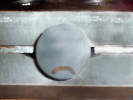Impact Performance of Polycrystalline Diamond Cutters
When conducting exploratory drilling for oil, gas, and other natural resources, it is often necessary to penetrate tough underground rock formations using drill bits made from ultra-hard materials. Drill bits made from industrial or natural diamonds, designed for such jobs, are manufactured under extreme temperature and pressure conditions to obtain maximum hardness and durability. Both of these features are key measures of performance in this abrasive, high-speed environment.
To remain competitive, drilling companies strive to maximize the rate at which the drill head penetrates into the rock. Prematurely worn or damaged drill bits can cause a slow down in this process. To reduce costly maintenance and improve drilling efficiency, manufacturers invest heavily in materials, equipment and R&D labs. Impact testers are among the tools found in these labs for comparing drill bit material composition, cutting structure, and manufacturing processes.
Test Configuration and Procedure
The drill bits were held at approximately 45 ° in a custom fixture developed in accordance to the industry. A Instron 9450 drop tower, instrumented with a 222 kN tup, DAS (Data Acquisition System), Bluehill Impact software, and a custom tup insert were used to perform the testing. Due to the toughness of the specimens the tup insert was designed to allow for the insertion and removal of a carbide indenter, which had to be replaced after each impact.
Each bit was impacted until it exhibited visible signs of failure – cracking, or discoloration in the face of the bit or material falling from the face. Impact energy was the controlling factor in the test methods used as the customers were interested in finding out the accumulative energy level at which the bits failed.
9400 Series Drop Tower Brochure
Instron Drop Towers are used to develop, fine tune, and validate material models. Testing materials under real impact conditions is a crucial step prior of product design. Using the characterization data obtained with the Instron 9400, coupled with customer supplied high-speed video, you can have confidence in your results and deliver new materials to your customers faster. Our Drop Tower impact systems, fixtures, and tups are designed to meet a wide range of applications and testing standards including: ISO, ASTM, ANSI, Airbus, Boeing, BSI, DIN, EN, FDA, Ford, GM, JIS, NASA, GOST, and more.
- Products
- 02/05/2020
- 763.1 KB
9400 Series Dashboard Brochure
Bluehill® Impact is built from the ground up for touch interaction. The Operator Dashboard features large touchpoints to make the user experience simpler and smarter. Easy-to-understand icons and workflows make it easy to train new or experienced users, simplify operator training, and allow you to start testing even faster than ever before
- Products
- 08/01/2019
- 2.35 MB

